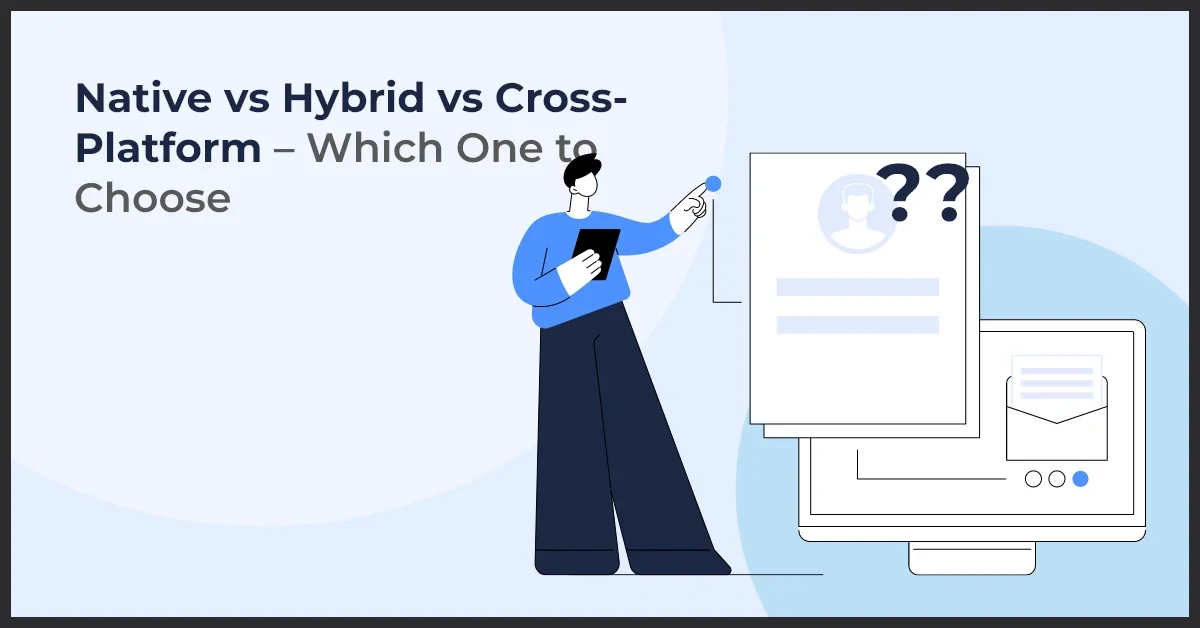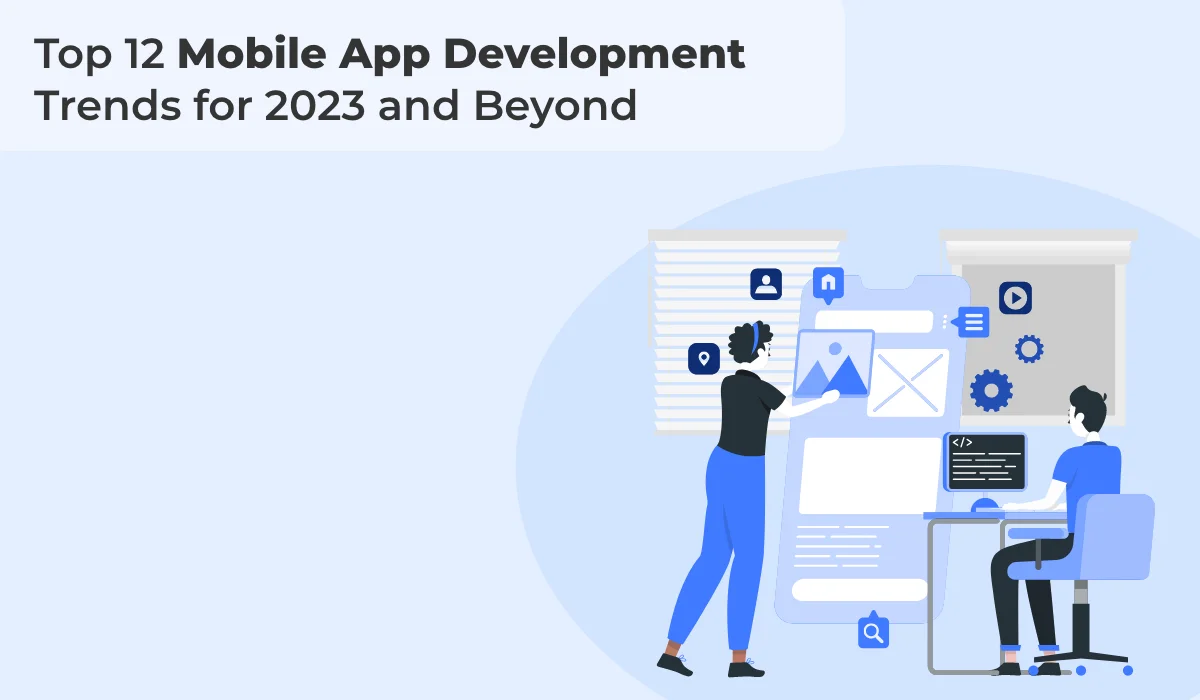Native vs Hybrid vs Cross-Platform – Which One to Choose?

Published on: January 30, 2022
Updated on: July 17, 2024
627 Views
- App Development
7 min read
Did you know that by 2023 the number of app downloads would reach the 300 billion mark? Mobile app development has come a long way since the launch of the Apple iPhone in 2008. Android soon followed and changed the way people accessed information on the Internet. At the last count, there are more than 4 million apps available for download on Apple App Store and Google Play Store. There are millions more across other platforms.
Mobile applications are no longer a novelty, but a must-have like your website and social media presence. Mobile devices account for close to 55% of the Internet share and this number is expected to grow further in the coming years. A mobile-friendly website isn’t enough and naturally, businesses have to opt for mobile app development.
However, the decision to invest in mobile app development can put you in a dilemma. Businesses need to choose the ideal technology that helps them meet their goals. Native, Hybrid, and Cross-Platform are the three distinct frameworks to choose from. In this blog, we shall look at the pros and cons of each and see which one your business must choose in 2022.
What Are Native Apps?
As the name suggests, native apps are designed exclusively for specific platforms. They leverage the native operating system of the platform and platform-specific programming languages. Since these applications are designed for a particular platform, they can take maximum advantage of the device-specific software and hardware, thus improving the user experience.
Developers use coding language specific to the OS. For example, in the case of iOS applications, Objective-C or Swift is the preferred language while Java is used for native Android applications.
Pros of Native Apps
- User experience is better in native apps as they draw the full potential of the hardware and software.
- Native apps have simpler coding in comparison to hybrid and cross-platform apps and hence are faster. Most app elements are built into the architecture that helps these apps load faster.
- Native apps are known for their offline functionality, which makes them ideal for areas with connectivity issues. This is a massive advantage as far as the usability of the application is concerned.
- Native apps are highly secure as they are implemented taking into account the vulnerabilities of individual platforms. There is less scope for bugs and virus attacks in these apps.
Cons of Native Apps
- Native app codes are non-reusable. For every native app, developers need to start from scratch which adds to development costs.
- Native apps come with high maintenance costs as the app needs constant updates with the change in hardware and software. Maintenance cost bills can easily exceed development costs.
- You need a large and specialized development team for native apps. Since these apps are platform-exclusive, the development team must be skilled in different platforms and programming languages.
What Are Hybrid Apps
Hybrid apps are a combination of web solutions and native app architecture. They combine the best of both worlds to create rich user experiences. A typical hybrid application has two components—a backend code that powers the application and a downloadable native viewer that is meant to offer the best user experience irrespective of the hardware or the operating system the device uses.
HTML, CSS, and JavaScript are used in Hybrid app development; these codes are embedded into native apps using plugins such as Apache Cordova, and Ionic Capacitor, to leverage the native platforms.
Pros of Hybrid Apps
- Hybrid apps have a faster time-to-market cycle as they are easier to develop compared to native apps.
- Since these apps are developed in widely-used programming languages, they are easier and cheaper to maintain.
- Hybrid apps aren’t expensive which is a big advantage for small businesses and startups that don’t have deep pockets.
- Hybrid apps are scalable and developers can easily target multiple OS and browsers using this development framework.
Cons of Hybrid Apps
- These apps have limited functionality as they are unable to leverage device-specific hardware such as AR.
- Hybrid apps lack offline capabilities like native apps and users need stable connectivity to enjoy all features and functionalities of the apps.
- Since Hybrid apps aren’t marketed through the app stores, businesses often find it challenging to promote these apps.
- Collecting usage data and other key metrics from these apps is a challenge as users need to constantly log into these apps and the login screen can limit engagement.
What Are Cross-Platform Apps
The uninitiated often tend to think of hybrid and cross-platform apps as the same. There is a world of difference between these two frameworks. Unlike hybrid apps that rely on web technologies, cross-platform apps are developed using non-web technologies such as Xamarin, React Native, and Flutter. They are built around the idea of code shareability where the code written for one platform can easily be employed elsewhere reducing the development cost.
Pros of Cross-Platform Apps
- In cross-platform app development, reusable code helps in increasing the productivity and efficiency of the app and results in a faster development cycle.
- Since cross-platform app codes are reusable that result in reduced development costs when the app is deployed on multiple platforms
- Cross-platform apps are cloud-friendly and can be seamlessly integrated into the cloud with a single source code.
- Cross-platform apps are easier and cheaper to maintain in comparison to native apps and even hybrid ones.
Cons of Cross-Platform Apps
- Cross-platform app development involves making compromises vis-à-vis the native capabilities of the platform and this results in poorer performance.
- These apps fail to take advantage of the user interface of high-end devices as they are developed under the lowest common denominator approach.
- Integration of cross-platform apps is a challenge and developers are often handicapped by the lack of tools for app development.
- Cross-platform apps suffer security challenges as unlike native apps, developers find it challenging to address vulnerabilities across platforms.
So Which App Development Platform Should Your Business Choose in 2022?
As you have already seen, each of these frameworks has its advantages and downsides, and picking a clear winner is next to impossible. Therefore, the best approach to choosing one among these three frameworks is to take into account your business’s project requirements, target audience, budget, and time to market factors.
If performance, customization, and security of the app are your primary concerns, you should not have any doubts about choosing the native app development framework. Native apps deliver the best performance and ensure the safety and security of user data. While hybrid and cross-platform apps aren’t insecure, native apps beat them by a mile on this parameter.
Businesses looking for a fast development cycle or planning to introduce an MVP and work on upgrades later should opt for the hybrid app development framework. These apps have the shortest development framework and can be introduced into the market in a short time. Cross-platform app development, on the other hand, is best suited for businesses with low budgets. Not surprisingly, most startups choose this framework as it is easier in their pockets.
The Final Verdict
Your business cannot do without a mobile application, especially in 2022 and beyond. Whether it is a native, hybrid, or cross-platform app you choose to develop, your decision should be based on your business needs, target audience, and development costs.
If you are looking for a team to design and develop your mobile app across the three frameworks, Growth Natives has you covered. We have a team of ace mobile developers with in-depth knowledge of these frameworks. We shall help you choose the best framework that meets your requirements. Write to us at info@growthnatives.com or visit our website to know more.



